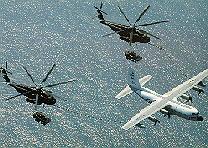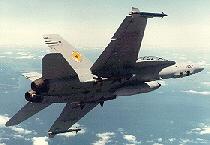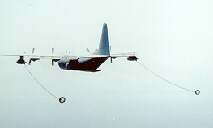 Marine Corps fixed-wing
aircraft support the MAGTF in all six functional warfare areas. In support
of the Commandant's Planning Guidance, a strategy of "necking down" the
number of aircraft models is being implemented. In the future, the Marine
Corps inventory will consist of two or three fixed-wing aircraft types.
This reduction supports the expeditionary nature of the MAGTF by reducing
aviation's logistical footprint. Replacement of the AV-8B and the F/A-18
with the STOVL version of JSF will further the goal of achieving an all-STOVL
aviation component.
Marine Corps fixed-wing
aircraft support the MAGTF in all six functional warfare areas. In support
of the Commandant's Planning Guidance, a strategy of "necking down" the
number of aircraft models is being implemented. In the future, the Marine
Corps inventory will consist of two or three fixed-wing aircraft types.
This reduction supports the expeditionary nature of the MAGTF by reducing
aviation's logistical footprint. Replacement of the AV-8B and the F/A-18
with the STOVL version of JSF will further the goal of achieving an all-STOVL
aviation component.
 conventional
airfields. This makes the aircraft particularly well-suited for providing
dedicated close air support.
conventional
airfields. This makes the aircraft particularly well-suited for providing
dedicated close air support.
There are three variants of the aircraft currently in service: the Day Attack, Night Attack, and Radar/Night Attack Harrier. The Night Attack Harrier improved upon the original AV-8B design through incorporation of a Navigation, Forward-Looking Infrared (NAVFLIR) sensor, a moving map, night vision goggle compatibility, and a higher performance engine. The current Radar/Night Attack Harrier, or Harrier II+, has all the improvements of the Night Attack aircraft plus the AN/APG-65 multimode radar. The fusion of night and radar capabilities allows the Harrier to be responsive to the MAGTF's needs for expeditionary, night and adverse weather, offensive air support.
The ongoing "remanufacture" program, in which 72 day-attack aircraft from the current inventory are being rebuilt to the Radar/Night Attack standard, extends the service life of these Harrier aircraft into the next century, and greatly improves their warfighting capabilities. Existing Harriers are also being upgraded through the use of COTS technology. The Open Systems-Common Architecture program will replace the existing Harrier Mission Computer with a COTS system that can be more affordably upgraded and maintained. The aircraft's weapons and communications systems will continue to be upgraded until it is replaced by the JSF.
Marine EA-6B squadrons are unique in regard to their integration with the Tactical Electronic Processing and Evaluation System (TERPES). This organic electronic reconnaissance and processing system provides the MAGTF commander with valuable Tactical Electronic Order of Battle information and access to national sensors. The system and its supporting analysts are colocated with the EA-6B squadron and other tactical aircraft requiring support.
The ongoing Block 89A upgrade program will address structural and supportability problems associated with the aging aircraft fleet. The upgrade also includes numerous avionics improvements for safety of flight and joint interoperability, including the ICAP-III program upgrade that Navy Prowlers are undergoing.

Procurement of new F/A-18Cs for the Marine Corps ended in FY 1996. The aircraft's weapons and communications systems will continue to be upgraded until it is replaced by JSF.
 MAGTF.
The aircraft also functions in the control of aircraft and missiles mission
area by acting as a Forward Air Controller (Airborne)/ Tactical Air Controller
(Airborne) (FAC(A)/TAC(A)) and by providing Strike Control and Reconnaissance
(SCAR). Like later model F/A-18Cs, the D model's avionics suite allows
it to conduct night operations below the weather using night vision goggles
and FLIR systems.
MAGTF.
The aircraft also functions in the control of aircraft and missiles mission
area by acting as a Forward Air Controller (Airborne)/ Tactical Air Controller
(Airborne) (FAC(A)/TAC(A)) and by providing Strike Control and Reconnaissance
(SCAR). Like later model F/A-18Cs, the D model's avionics suite allows
it to conduct night operations below the weather using night vision goggles
and FLIR systems.
In the future, an additional warfare area ‹ aerial reconnaissance ‹ will be added to the aircraft's repertoire. The Advanced Tactical Airborne Reconnaissance System will permit the F/A-18D to provide real-time aerial imagery to the MAGTF, naval forces at sea, or joint forces ashore via a digital data link. This system is scheduled for deployment in FY 1999.
 The KC-130 is a multi-role,
multimission tactical tanker and transport aircraft, well-suited to the
mission needs of the forward-deployed MAGTF. The only long-range assault
support capability organic to the Marine Corps, this aircraft provides
both fixed-wing and rotary-wing tactical in-flight refueling; rapid ground
refueling of aircraft or tactical vehicles, assault air transport of air-landed
or air-delivered personnel, supplies and equipment; command and control
augmentation; pathfinder; battlefield illumination; tactical aeromedical
evacuation; and search and rescue support. The new KC-130J, with its increase
in speed, range, improved air-to-air refueling system, night systems, and
survivability enhancements, will provide the MAGTF commander with a state-of-the
art, multimission, tactical aerial refueler/transport well into the 21st
century.
The KC-130 is a multi-role,
multimission tactical tanker and transport aircraft, well-suited to the
mission needs of the forward-deployed MAGTF. The only long-range assault
support capability organic to the Marine Corps, this aircraft provides
both fixed-wing and rotary-wing tactical in-flight refueling; rapid ground
refueling of aircraft or tactical vehicles, assault air transport of air-landed
or air-delivered personnel, supplies and equipment; command and control
augmentation; pathfinder; battlefield illumination; tactical aeromedical
evacuation; and search and rescue support. The new KC-130J, with its increase
in speed, range, improved air-to-air refueling system, night systems, and
survivability enhancements, will provide the MAGTF commander with a state-of-the
art, multimission, tactical aerial refueler/transport well into the 21st
century.